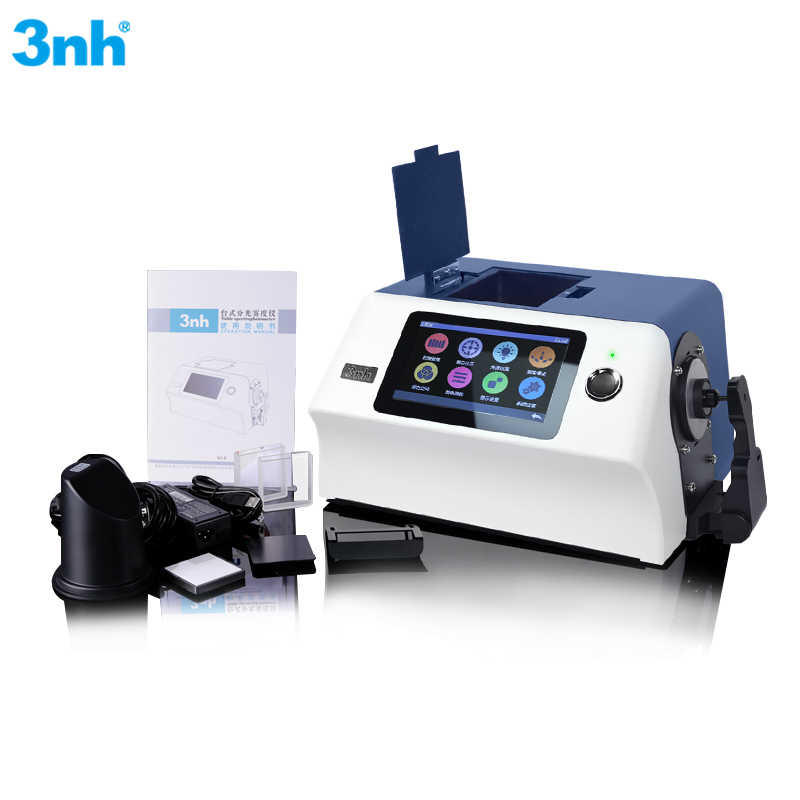How to distinguish between a colorimeter and a spectrophotometer?
How to distinguish between a colorimeter and a spectrophotometer?
As the name suggests, a “colorimeter” is used to measure the color difference between two samples. It generally cannot provide the color coordinate space of the color, but can provide the color difference value (ΔE) between two samples (usually between the standard and the sample). This type of colorimeter does not have color data, has no way to exchange data with others, and cannot establish and manage its own color standard database.
Spectrophotometers offer high accuracy and utilize pre-calibrated plates, eliminating the need for standard black and white boards, a common feature of traditional colorimeter and colorimeter calibration. The built-in software includes powerful functions, including all necessary color equations, standard light sources suitable for different tasks, and numerous industry- and application-specific specifications.
Spectrophotometers are designed based on the principle of spectroscopy, while standard colorimeters are based on the principle of tristimulus values. They offer high precision and increasing versatility. Spectral spectrophotometers can simultaneously measure both SCI (a measurement method that includes specular reflection. This minimizes the influence of the sample surface and is particularly suitable for color quality monitoring and computer color matching) and SCE (a measurement method that excludes specular reflection. This type of measurement produces results similar to those observed by the naked eye). Because they measure reflectance at each wavelength, they are suitable for complex color analysis, though they are relatively expensive. Tristimulus colorimeters are relatively inexpensive, compact, highly portable, and easy to operate.
Colorimeter
Portable Spectrophotometer
Benchtop Spectrophotometer
Comparison of the advantages and disadvantages of spectrophotometer and colorimeter:
1 ) Analysis of the advantages of spectrophotometer and colorimeter
Spectrophotometers can simulate a variety of light sources and measure the “reflectance curve” of each color point. Compared with ordinary colorimeters, they have more comprehensive functions and more stable and accurate measurements.
The colorimeter can give the color difference between the standard sample and the comparison sample, and the price is relatively low.
2 ) Analysis of Disadvantages of Spectrophotometers and Colorimeters
Different spectrophotometer models produce significantly different measurement results and have varying degrees of accuracy. Due to their high accuracy, spectrophotometers on the market are expensive and difficult to repair.
Although relatively inexpensive, colorimeters have significant drawbacks, including low accuracy, limited functionality, and limited ability to measure color differences. Different models of colorimeters often read different results, making it impossible to exchange data with others and establish and manage a standard database.
It can be seen that, ignoring the price condition, people still tend to choose spectrophotometers. After you buy a spectrophotometer, do you know how to use it?
3 ) Here is a brief introduction to the use of spectrophotometer (taking a desktop spectrophotometer as an example)
Turn on the spectrophotometer and start the spectrophotometer software on the computer desktop. After the software is started, calibrate the spectrophotometer first. After the calibration is completed, use a white board or green board for measurement. It is worth mentioning that when measuring with a spectrophotometer, you must first determine the measurement mode to be used, and then call the required standard sample from the database. The above is how to use the spectrophotometer. The instrument is not difficult to operate, but there may be a lot of steps. You need to follow the steps. Do not operate without following the steps or skipping the steps, as this will cause deviations in the measurement results.

A Guide to Choosing the Best Spectrophotometer
A purchase of a spectrophotometer must be appropriate in line with the working conditions. The possible implications of choosing an incorrect model would include additional expenses, efficiency problems at the working level, and even a reduction in the quality of the product. Being aware of what is critical during the selection process enables the buyers to generate superior decisions in the long run.
1. Application-Specific Requirements
Measuring capabilities are required in different industries. As an example, a cosmetics firm may wish to be able to apply color to creamy or powdery surfaces, and a textile manufacturer needs an instrument to measure flexible, woven texture. The type of material, the finishing of the surface, and the environment are the key considerations needed in choosing the correct device.
2. Accuracy and Resolution
The spectrophotometers required in the high-precision applications are of strict tolerance levels and high resolution. As an example, an automotive paint shop can not even tolerate the slightest deviation, as all mismatched panels would be obvious. At higher resolutions, the device is able to see very minor disparities between samples that are important in color-critical production.
3. Ease of Use and Workflow Integration
The production lines should not be slowed down by spectrophotometers. The intuitive touchscreens, ease of operation with calibration programs, and rapid measurement cycles of these models aid in minimal impact of change on the routine efforts. Direct transfer of data is also possible with colour management software compatibility. This ensures that errors that would have otherwise been made through manual entry of data are avoided.
4. Portability vs. Benchtop Models
Portable spectrophotometers are perfect for running color checks in the field, at points of sale, or when large manufacturing facilities need to be mobile. The benchtop models, however, are more stable in terms of measurement. They are usually more applicable to laboratory experimentation or batch approvals in which precision is demanded.
Learn more https://www.threenh.com/Product_News/Difference-Between-Colorimeter-Spectrophotometer.html

